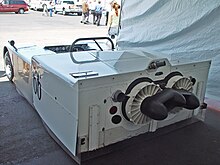Chaparral Cars


Chaparral was a racing car project by Texan racing driver and designer Jim Hall that lasted from 1963 to 1970. The name was derived from the road cuckoo bird , also known as the Road Runner .
history
The technically revolutionary vehicles were characterized among other things by the first successful use of automatic transmissions (2D, 1966), huge rear wings (2E, 1966 and 2F, 1967) and the first "vacuum cleaner racing car" (2J, 1970). In this regard, they pioneered numerous other designs. The Formula 1 took over the rear wing a year later; Brabham copied the "vacuum cleaner" with the Brabham BT46B .
The Chaparral models were designated by age group with 2 (1963), 2C (1965), 2D (1966), 2E (1966), 2F (1967), 2G (1968), 2H (1969) and 2J (1970). The Chaparral prototypes won several races or set fastest lap times in the United States. They were driven by Chevrolet -Zweiventil- suction - V - eight cylinders . A technical highlight was the Type 2J from 1970, which also had a two-stroke engine and side skirts. This ILO - snowmobile engine driving two 17-inch fan at a constant speed of 5000 / min at that draw in the air from under the car and for an increased contact pressure ensured. The additional downforce is stated to be 900 pounds (4 kN ). However, the 2J would not have been able to drive on the ceiling with it, as is often rumored.
Technical specifications
| Chaparral: | 1966 (2D) | 1967 (2F) |
|---|---|---|
| Engine: | V8 cylinder, 90 ° | |
| Displacement: | 5354 cm³ (327 ci ) | 6996 cm³ (427 ci) |
| Bore × stroke: | 101.6 x 82.55 mm | 107.98 x 95.5 mm |
| Power: | 316 kW (430 hp) | 405 kW (550 PS) |
| at 1 / min: | 6800 | 6500 |
| Compression: | 11.0: 1 | 11.0: 1 |
| Transmission: | 2-speed automatic | 3-speed automatic |
| Wheelbase: | 2340 mm | 2380 mm |
| Wheel size: | 9 / 12-15 | 6.50 / 7-15 |
| Dry weight: | 780 kg | 830 kg |
The vehicles became known to the European public less through the victory of Phil Hill / Joakim Bonnier at the Nürburgring in 1966 than through the numerous miniature models of these racing cars that could be found in every toy store in the late 1960s and early 1970s.
Results
Victories in the sports car world championship
| year | run | vehicle | Driver 1 | Driver 2 |
|---|---|---|---|---|
| 1965 | Sebring 12 hour race | Chaparral 2A |
|
|
| 500km Bridgehampton race | Chaparral 2A |
|
||
| 1966 | 1000 km race on the Nürburgring | Chaparral 2D |
|
|
| 1967 | Brands Hatch 6 hour race | Chaparral 2F |
|
|
literature
- Karl Ludvigsen: Chaparral - Can-Am Racing Cars from Texas. 2002, ISBN 978-1-58388-066-1 .
Web links
Individual evidence
- ↑ chaparralcars.com Legacy (accessed January 10, 2014)
- ↑ motorauthority.com Static Downforce Systems Suck To Generate More Grip (accessed January 11, 2014)
- ↑ photoessayist.com The Increbible Chaparral 2J (accessed January 11, 2014)
- ↑ See also Karl Ludvigsen: Chaparral. P. 119
- ↑ 450 bhp. See Ludvigsen, p. 63
- ↑ 525 bhp at 6000 rpm. See Ludvigsen, p. 71
- ↑ Data according to the ADAC 1000 km race programs.
- ^ Karl Ludvigsen: Chaparral . Pp. 63, 71
- ↑ Successes in the sports car world championship in 1965 ( Memento from June 24, 2003 in the web archive archive.today )
- ↑ Successes in the sports car world championship in 1966 ( Memento from December 19, 2003 in the web archive archive.today )
- ↑ Successes in the sports car world championship 1967 ( memento from June 24, 2003 in the web archive archive.today )


